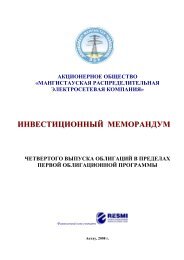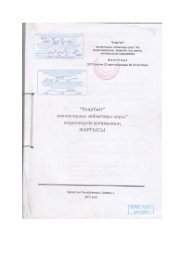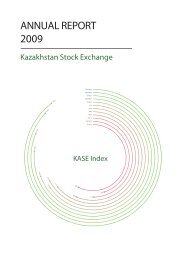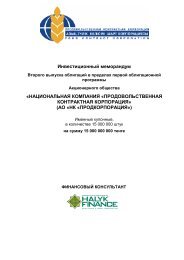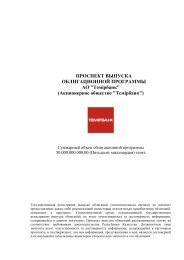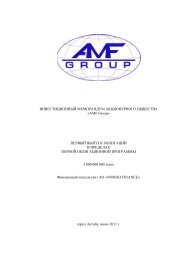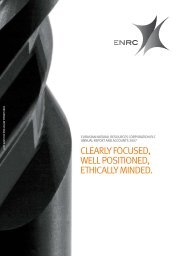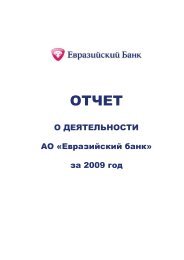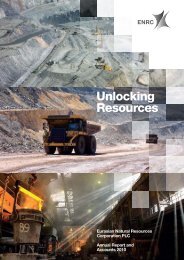JPMorgan - KASE
JPMorgan - KASE
JPMorgan - KASE
You also want an ePaper? Increase the reach of your titles
YUMPU automatically turns print PDFs into web optimized ePapers that Google loves.
The Government has made radical reform of the pension system and, in June 1997, “enacted” a<br />
new law and made amendments to various other laws facilitating pension reform (together the<br />
“Pension Laws”). The Pension Laws establish a legal framework for the transfer of the pension<br />
system from a State “pay as you go” system to a “fully funded” accumulative pension system. The<br />
aim is that private individual retirement accounts will be the main source of pension payments.<br />
Social allowances for qualifying persons (e.g., disabled persons), which had previously been paid<br />
through the State pension system, are now paid through local budgets. Individual accounts are<br />
maintained with pension funds managed by pension asset management companies licensed and<br />
supervised by the NBK. Pension asset management companies are subject to regulations,<br />
including various financial ratios (such as capital adequacy requirements) similar to those<br />
imposed on banks and investment requirements. As of 1 January 2002, pension fund assets<br />
amounted to 182.4 billion Tenge compared to 112.9 billion Tenge as of 1 January 2001 and 64.6<br />
billion Tenge as of 1 January 2000. The percentage of assets accumulated by the State<br />
accumulative pension fund as of 1 January 2002, equaled 32.3 percent. of the total volume of<br />
accumulated pension assets (compared to 38.9 per cent. as of 1 January 2001 and 52.5 percent. as<br />
of 1 January 2000). As of 30 June 2002, the pension fund assets had increased to 222.1 billion<br />
tenge.<br />
The Pension Laws increased the pension age from 55 to 58 for women and from 60 to 63 for<br />
men. A social tax of 21 per cent. of total wages is payable by employers and employees are<br />
obliged to pay 10 per cent. of their salaries into their private pension and are permitted to make<br />
additional contributions to their respective private pension funds.<br />
Although the changeover to a fully funded system will take many years to complete and until<br />
then the legacy of the old system will remain a burden on the State’s resources, the introduction<br />
of a “fully funded” pension system has been successful and it has achieved significant results<br />
within its first four years. The sound growth of the pension industry provides is basis of the rapid<br />
development in the Kazakhstan’s financial and capital markets.<br />
Environment<br />
Kazakhstan faces significant environmental problems which, to a large extent, stem from the<br />
period when it was part of the former Soviet Union. Outdated technology and capital equipment<br />
in the metallurgical sector produce heavy pollution, mostly in the north and east of the country.<br />
Semipalatinsk, a city in north east Kazakhstan, has a military facility which until 1990 was used<br />
for nuclear testing and many locations in the vicinity are heavily contaminated by radioactive<br />
waste. Other locations in Kazakhstan were used by the Soviet Union for the testing of biological<br />
weapons and are as a result contaminated with various pathogens.<br />
The former Soviet Union’s “Virgin Lands” policy of the 1950s and 1960s, whereby large areas of<br />
Kazakhstan’s steppe land were ploughed to increase Soviet grain production, has led to soil<br />
erosion on a wide scale and up to 66 per cent. of Kazakhstan’s agricultural land is under threat of<br />
desertification. Excess irrigation has halved the surface area of the Aral Sea in southern<br />
Kazakhstan exposing land which is unsuitable for agriculture. Further, the Caspian Sea suffers<br />
from serious pollution due to industrial dumping.<br />
In 2001, the Ministry of Natural Resources and Environmental Protection’s budget for<br />
environmental protection and the safe-guarding of the water supply was 4.97 billion Tenge.<br />
Natural Resources<br />
Introduction<br />
The extraction and production of hydrocarbons and minerals are the most significant industries<br />
in the Kazakhstan economy. The export of hydrocarbons and minerals accounted for 58.0 per<br />
cent. of total exports in 2001. According to official estimates, oil and gas reserves are significant<br />
and to a large extent have not been fully explored.<br />
B-10




